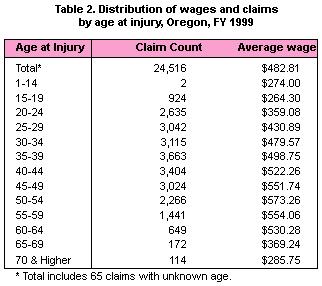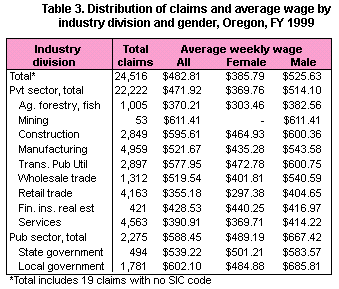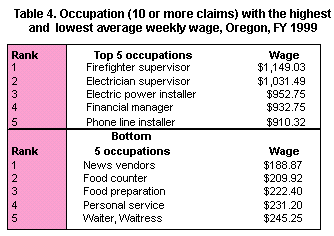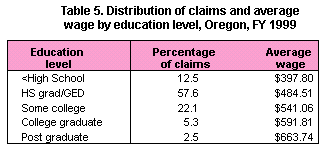
The average weekly wage for Oregon workers disabled on the job during fiscal year (FY) 1999 was $482.81. The average weekly wage for all workers (excluding federal employees) was $573.39; a difference of $90.58. Table 1 documents the trend in the relationship between injured workers’ wages and the rest of the work force. Each year since FY 1984 the gap between the average weekly wage for injured workers and the average wage for the state has been growing. However, in FY 1999, the gap narrowed slightly because the average wage for injured workers grew faster than the average wage for all Oregon workers. For more information on this subject, the publication Differences in Average Weekly Wages is available upon request.

Injured workers who are “disabled” for more than three calendar days receive time loss benefits equal to two-thirds of their weekly wage at the time of injury, up to a maximum benefit. For FY 1999, the maximum benefit was $576.64. The maximum benefit changes each July 1, with the time loss maximum set to the average weekly wage of all Oregon employees during the fourth quarter of the preceding calendar year.
During FY 1999, 1,886 injured workers (7.7 percent of all injured workers) had weekly wages above $864.96, which is the wage at which claimants receive the maximum benefit. Were there no benefits limitation, these higher-wage workers would have received time loss in excess of $576.64. However, any adverse effects of the benefit structure depend upon the extent to which tax-free workers’ compensation benefits replace after-tax earnings or purchasing power. Figure 1 shows the distribution of both wages and claims at $100 intervals for FY 1999.

Table 2 shows the distribution of cases by age. Of the FY
1999 claims, 54.6 percent were for workers aged 39 and younger with the greatest number in the 35-39 age group. The number of
claims per age group steadily declines thereafter. The average
wage, however, increased until peaking at $573.26 for the 50-54
age group.
with the greatest number in the 35-39 age group. The number of
claims per age group steadily declines thereafter. The average
wage, however, increased until peaking at $573.26 for the 50-54
age group.
Table 3 presents wage data by claimant’s gender and industry division as determined by the Standard Industrial Classification (SIC) of the employer at time of injury. In FY 1999, women accounted for 30.6 percent of all claims, continuing a trend of frequencies between 28 and 33 percent. The average wage for females workers was $385.79 while male workers averaged $526.63 per week. The service industry had the most claims by females, 2,390, and the second highest number of claims overall at 18.6 percent of the total. Manufacturing had the highest number of claims with 20.2 percent of the total. Mining had the highest average weekly wage at $611.41, while the retail trade had the lowest average weekly wage at $355.18.

Table 4 shows the occupations (10 or more claims) with the highest and lowest average weekly wages. The occupations with the most claims in FY 1999 were truck driver and laborers except construction. Truck drivers accounted for 9.6 percent of all claims (2,349 claims) and laborers accounted for 8.8 percent of all claims (2,146 claims). The average weekly wage for truckers was $595.68 and for laborers it was $410.05.

Table 5 depicts the percentage of claims and the average weekly wage by highest level of formal education at the time of injury. High school graduates accounted for 57.6 percent of all claims. The table shows that the weekly wage increases with each level of formal education completed.

If you have questions about the information
contained in this document please contact by e-mail or phone:
Ronni Rachele Assistant
Research Manager, Research & Analysis Section, Information Management
Division (503) 947-7307. This document was originally published in July
2000. [Printed form: 440-2121(07/00/imd)]
In compliance with the Americans with Disabilities Act (ADA), this publication is available in alternative formats by calling (503) 378-4100 (V/TTY). The information in IMD publications is in the public domain and may be reprinted without permission.